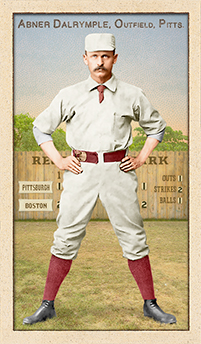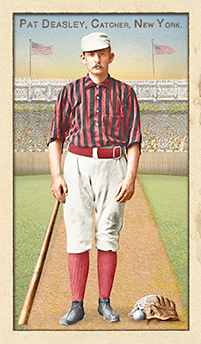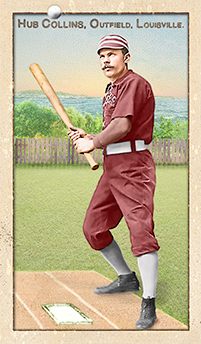
- Series: Beginnings: 1880's
- City: Louisville
- Team: Colonels
- League: American Association
Hubert B. Collins (1864-1892) was a good-hitting outfielder/second-baseman for two major league clubs from 1886-1892. He came up with the Louisville Colonels of the American Association and moved to the Brooklyn Bridegrooms late in the ‘88 season. Hub played out his career in Brooklyn in both their AA and NL franchises. He managed a fine .284 lifetime average in seven years. In 1890 during his team’s back-to-back title years, Collins led the league in runs scored. The young Louisville native had begun in pro ball with Columbus in the Southern League in ‘85 and came up to his hometown team the next year from Savannah.
- Brooklyn paid the Colonels $4500 for the young utility man in September 1888
- Hub suffered a head injury in a horrific collision with Tom Burns in July 1891. A passing locomotive drowned each others’ call for the short fly ball. He never recovered, succumbing to typhoid fever the next spring
- Hub's uniform color on this card was changed in January, 2017 from blue to maroon to reflect recent reliable research by Craig Brown & friends at Threads of Our Game. Four cards had been previously released featuring a blue uniform.
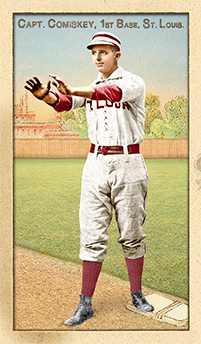
- Series: Beginnings: 1880's
- City: St. Louis
- Team: Browns (AA)
- League: American Association
- Hall: National Baseball Hall of Fame
Charles Albert Comiskey (1859-1931) rose from decent first-baseman to become one of the foremost managers and owners of baseball’s early decades. “The Old Roman’s” leadership skills emerged with his first team, the newly-minted St. Louis Browns whom he piloted to four pennants. He would go on to compile an outstanding 840-541 record. His .608 winning percentage is third-highest behind Joe McCarthy and Jim Mutrie. “Commy” parlayed his ownership of the Western Association’s Dubuque Rabbits into a franchise in the American League which he helped found in 1901. He built the White Sox stadium in 1910 which would bear his name for the next 81 years and presided for the next decade over one of the most talented and troubled teams in history. While many dismiss the charge that it was Comiskey’s penurious ways that “drove” his 1919 squad to infamy, there is no doubt he was a cheapskate of the first order. He underpaid, over-promised and reneged with abandon, epitomizing the arrogance of the reserve-clause era.
- Charles is credited with revolutionizing play at first-base, innovating play off the bag
- Owned the Chicago White Sox from 1901-1931, winning two World Series
- Elected to Hall of Fame: 1939

- Series: Beginnings: 1880's
- City: New York
- Team: Giants
- League: National League
- Hall: National Baseball Hall of Fame
Roger Connor (1857-1931) was the home run king of the 19th century, clouting 138 in his 18-year career. His record stood for 23 years after his retirement, until Babe Ruth surpassed him in 1921. Connor anchored first-base for five teams, winning pennants twice with the Giants. His flair for the dramatic was never more evident than when he struck the first-ever major league grand slam with his team down by three with two outs in the ninth. Born in Connecticut, Roger played for local clubs until joining the Troy Trojans in 1880. That NY hamlet witnessed five future Hall of Famers on their squad with Connor playing alongside Dan Brouthers, Buck Ewing, Tim Keefe and Mickey Welch. After moving to the Gothams, the 6’3” Connor inspired owner Jim Mutrie to proclaim the team “my giants!” and a new identity was born.
- Much more than a slugger, Connor won the NL batting title in 1885 and consistently hit .300+ while exhibiting remarkable speed for a big man (still fifth all-time in triples)
- Connor lived to see Ruth claim his HR title. It was thought at the time, however, that Connor had hit 131 HRS and Ruth's record was celebrated at 132. Writing for SABR in 1975, John tattersall discovered that Connor had actually hit 138 HRs.
- Jay Jaffe's JAWS system ranks Connor as the 5th greatest 1st baseman of all-time, just behind Cap Anson and just ahead of Jeff Bagwell
- Beloved by fans and the baseball press, he had a particularly strong advocate for the Hall in fellow legend, umpire Bill Klem
- Elected to Hall of Fame: 1976
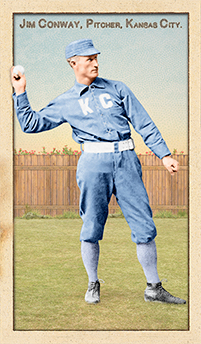
- Series: Beginnings: 1880's
- City: Kansas City
- Team: Blues (WA)
- League: Western Association
James P. Conway (1858-1912) pitched briefly in 1884 and ‘85 for the Brooklyn Atlantics and Philadelphia Athletics of the American Association. He was 3-9 for the Brooklyn and 0-1 for the A’s before returning to the minors, primarily in the Western and Southern leagues. Jim came back up with the Kansas City Blues in 1889 and had a fine season, winning 19 as the ace of a struggling team that finished 7th in the AA. The year before, Jim’s kid brother Pete had won 30 games for the Detroit Wolverines but quickly faded from the game along with Jim who’s arm gave out after that one stellar year. Jim managed to return to the mound after a year’s layoff but went only 8-12 for two minor league clubs in 1891-92.
- It has been speculated that Conway’s demise as a major-league pitcher had more to do with attitude than physical limitations. He was nicknamed “Dark Days” to signify a sour disposition
- Jim was a teammate of Hall-of-Famer Billy Hamilton who stole 111 bases in 1889

- Series: Beginnings: 1880's
- City: Boston
- Team: Beaneaters
- League: National League
Richard Butler Conway (1865-1926) earned quite a reputation for toughness in his native Lowell, MA and the New England League. Although his reliance on his off-speed pitches signaled a short career in the majors (in an era when the heater dominated from fifty feet), Conway's overhand fastball clocked Bill McGunnigle, fracturing his skull and ending a playing career for the future National League manager. The reputation may have stemmed less from the beaning than the fact that it was the third straight high hard one that decked Mac at Brockton that summer of 1885.
Conway was signed to his first major league contract with the American Association's Baltimore Orioles in 1886 but was soon returned to the minors. He got a big break after pitching his Portland team to a win in Boston against the Blues who shared the South End Grounds with the Beaneaters, bringing him to the NL's attention. Boston hired him for the '87 campaign. The Globe faulted his reliance on his curve and “using his arm entirely....He fails to get any speed on the ball and much strength is wasted.” Nevertheless, Dick's debut showed promise and the same paper lauded his effective control and all-around play. After going 5-1, the league caught on to him and he finished 9-15.
- Plagued with a sore arm, Conway ended his two-plus years MLB tenure with a 15-24 record and 4.78 ERA
- Dick was part of a “brother battery” with older sibling Bill with the '86 Orioles, among only sixteen such pairings in the majors
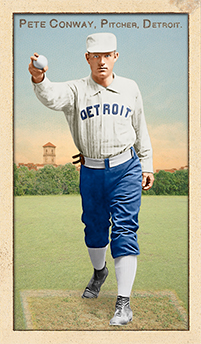
- Series: Beginnings: 1880's
- City: Detroit
- Team: Wolverines
- League: National League
Peter J. Conway (1866-1903) was a tough right-hander who played in tough luck with his early major-league clubs. Both the Buffalo Bisons and Kansas City Cowboys struggled to seventh-place finishes and failed to support their youngster during the 1885-86 seasons. He came into his own with a much better Detroit Wolverine squad for three years, helping the club win the pennant and post-season tourney in ‘87. Pete’s best year was in ‘88, going 30-14. The Wolverine franchise and Conway’s arm gave out. Pete went to the Alleghenys but got into only three games. Pressures were building that would culminate in the Players’ League “revolt” and the cavalier treatment Conway received in Pittsburgh was widely seen as all-too-typical. Pete tried unsuccessfully to play for Ward’s Wonders in 1890 but the arm was gone.
- In 1891 Conway was hired as the first head coach of the other Wolverines: those of the University of Michigan

- Series: Beginnings: 1880's
- City: Louisville
- Team: Colonels
- League: American Association
Paul Cook (1863-1905) got into three games at catcher for Harry Wright’s struggling Philadelphia Quakers at the end of the 1884 season. He returned to the minors before getting picked up by the Louisville Colonels where he stayed four years before jumping to Ward’s Wonders for the Players’ League season of 1890. Cook finished up the following year with three teams, back in Kentucky, then the Lincoln Rustlers and, finally, the St. Louis Browns. During his five years with the Colonels, Cook batted a mere .219 with no power.
- In his early days, Cook played for Muskegon in the Northwestern League, the Toledo Avengers of the Western League, and the Washington Nationals of the Eastern League
- Paul played in D.C. for manager Mike Scanlon who would lead the club in ‘86 as they joined the National League
- Cook's uniform color on this card was changed in January, 2017 from blue to maroon to reflect recent reliable research by Craig Brown & friends at Threads of Our Game. One card had been previously released featuring a blue uniform.

- Series: Beginnings: 1880's
- City: Indianapolis
- Team: Hoosiers (NL)
- League: National League
Lawrence J. Corcoran (1859-1891) was a shining star who left a short trail through the baseball heavens before flaming out in ill-health and an exhausted right arm. He could even use the left one and did pitch ambidextrously on at least one occasion. Few players of any era could have better fulfilled media prophecy: on Sept 13, 1879 the NY Clipper predicted that with good catching support “it would be difficult to get a base hit from his pitching.” Only two others would exceed Larry’s rookie 43 win total. By 1884 Corcoran would hurl his third no-hitter. He was the first to accomplish the feat and it wasn’t matched until Koufax many decades later. For five glorious years with Anson’s White Stockings, Corcoran was phenomenal: 170 wins, 246 CG and the no-nos.
- Unsurprisingly, the arm wearied. His body, afflicted by Bright’s disease, failed too, at age 32
- Per his SABR biographer: “Corcoran possessed all the attributes of greatness except durability”
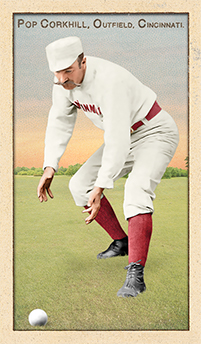
- Series: Beginnings: 1880's
- City: Cincinnati
- Team: Red Stockings (AA)
- League: American Association
John Stewart Corkhill (1858-1921) was an excellent fielder who found steady work in the outfields of the Red Stockings and Bridegrooms from 1883-90. Pop was still in demand and played out his career in Philadelphia and Pittsburgh before a beanball served up by Ed Crane prompted the veteran to hang ‘em up in 1892. Corkhill led the league in fielding several times, twice with his first club in Cincinnati and twice in Brooklyn where he played for pennant-winners in ‘89 (NL) and ‘90 (AA). A clutch hitter, Pop drove in 97/97/93 during a fine stretch from 1886-88. Proving his versatility, Corkhill made relief appearances in five seasons. He recorded two saves in an era not known for bullpen assistance.
- Corkhill was acquired by Brooklyn late in the ‘88 season along with the notoriously voluble Oyster Burns as owner Charles Byrne assembled a powerful squad
- Pop’s NY Times obituary noted that he had established a record with Cincinnati, playing three consecutive years without dropping a fly ball
- Corkhill passed away at home following surgery. It is unknown whether this was related to his career-ending injury
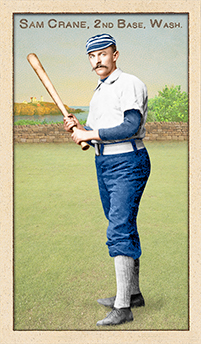
- Series: Beginnings: 1880's
- City: Washington, D.C.
- Team: Nationals
- League: National League
Samuel Newhall Crane (1854-1925) played second base for eight major league teams in three leagues from 1880-90. Sam lacked power (three career HRs, .203 average) despite a sturdy 6’, 190-lb frame. He was only a little more adept stealing bases (25 over the decade). Somehow, the practice of thievery on the bases carried over into Sam’s private life and his mediocre tenure in the big leagues ended ignominiously when he was accused of stealing a local merchant’s cash and wife. Such a checkered past was no hindrance to a longer career as a sportswriter. True to his tarnished image, Sam was mired in controversy as a scribe, getting himself barred from the Polo Grounds after attacking Giants’ owner Andrew Freedman in print. Whatever unpaid debts Crane left on the field or in the press box, he more than made up for by becoming an early and ardent promoter of creating a “memorial” to past stars of the game in Cooperstown, NY. His and others' efforts eventually led to the establishment of the National Baseball Hall of Fame in Cooperstown in 1939.
- Crane’s ouster amid the “circus” atmosphere surrounding the Giants made him a brief cause celebre among journalists aghast that one of their own should be censored
- Crane's uniform color on this card was changed in February, 2017 from black to blue to reflect recent reliable research by Craig Brown & friends at Threads of Our Game. Two cards had been previously released featuring a black uniform.

- Series: Beginnings: 1880's
- City: Chicago
- Team: Maroons
- League: Western Association
John T. (or F.) Crogan is another of those tantalizing “mystery men” of the Old Judge card era. Many of their subjects were photographed in anticipation of a major league career that never happened. In this case, Jack was posed for five images in the OJ 1888 series. He wears the uniform of the Chicago Maroons of the Western Association as depicted in the Miller/Gonsowski/Masson definitive OJ text with middle initial T. whereas Baseball-Reference.com has him with F. Prior to his brief time with the Maroons (21 games, .188 BA) Jack was with Wheeling in ’87, apparently his first year in the minors. He went on to play in the Texas and Tri-State Leagues before finishing up with Davenport of the Illinois-Iowa League in 1891. The rest of this would-be big leaguer’s exploits are lost to history.
- The Miller compilation shows a possible alternate surname spelling of Croghan
- The only batting pose available shows Jack in a left-handed stance
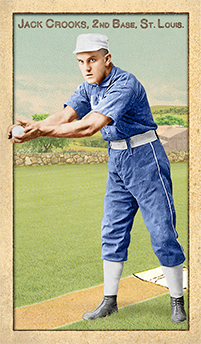
- Series: Beginnings: 1880's
- City: St. Louis
- Team: Whites (WA)
- League: Western Association
Charles John Crooks (1865-1918) became the first player in organized ball known to have hit four home runs in a game, accomplishing the feat for the Omaha Omahogs in 1889. The whole Western League had struggled to stay afloat that year and the team’s sale of Crooks to the American Association’s Columbus Colts that summer enabled them to make a profit (Omaha got $1750 for their outfielder and netted $1000 for the year). The four homers proved his strength but it was Crooks’ uncanny ability to draw walks that made him most valuable. He remains among a handful of players to record more bases on balls than games in a season, ranking him with the likes of Ted Williams, the Mick and the Babe. With a lifetime OBP of .408 and a BA of .237, Jack is in the top-ten highest ratio of the two.
- Despite Jack’s sabermetric value, the 1890 Colts were his only winning team in an 8-year career
- Jack cut short his baseball career after finding success as a cigar salesman
- Series: Beginnings: 1880's
- City: Louisville
- Team: Colonels
- League: American Association
Lafayette Napoleon Cross (1866-1927) debuted in the majors as a catcher for Louisville, transitioned to being a stellar third-baseman and went on to a remarkable 21-year career for nine teams including four Philadelphia clubs in four leagues. He was a solid hitter as well, ranking high in a number of offensive and defensive categories upon his retirement in 1907. His longevity allowed him to be the only player to appear in both the Old Judge card series and the 1910 T210 set.
- At 40, led league in fielding for fifth time
- His career .292 average included 2645 hits
- Career assists record was not eclipsed until Eddie Mathews surpassed him in 1964
- Lave’s uniform color on this card was changed in February, 2017 from blue to maroon to reflect recent reliable research by Craig Brown & friends at Threads of Our Game. Nine cards had been previously released featuring a blue uniform.
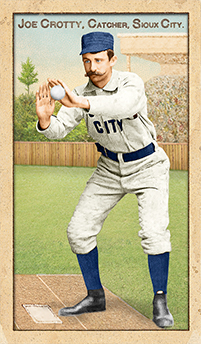
- Series: Beginnings: 1880's
- City: Sioux City
- Team: Corn Huskers
- League: Western Association
Joseph P. Crotty (1860-1926) was a catcher in two leagues: the American and Union Associations. He was in these organizations with 4 clubs from 1882 to 1886. Before, during and after these years in the “major leagues,” Crotty floated among numerous minor league franchises including the Sioux City Corn Huskers in whose uniform he appeared in the Old Judge series for 1889. A journeyman receiver, Crotty had a typically anemic batting average (.170 in MLB) but fared 100 points higher when in the lower echelons. His career did allow him to see the country: as far east as Syracuse, south to Jackson and west to Helena. Joe’s initial year, 1882, was also a year of firsts for his two clubs. He began in Louisville with the new Eclipse squad and then was picked up by Chris von der Ahe’s St. Louis Brown Stockings. This enabled him to be present at the creation of the Cardinals as the controversial owner brought the team into the American Association.
- Joe’s other ML clubs were the Cincinnati Outlaw Reds and the NY Metropolitans
- The Reds played in the UA’s only season, 1884, affording Crotty another chance to make a kind of history
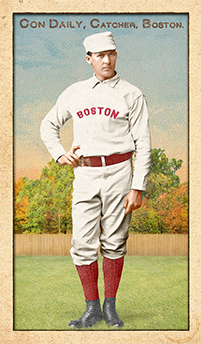
- Series: Beginnings: 1880's
- City: Boston
- Team: Beaneaters
- League: National League
Cornelius F. Daily (1864-1928) was a veteran of 13 ML seasons as a reliable and beloved catcher for some of the most colorful teams of his day. He caught Old Hoss Radbourn with the Providence Grays and moved with his battery mate to the Beaneaters in 1886. Later, Con was a favorite of John Montgomery Ward, playing for Ward’s Wonders in Brooklyn in the short-lived Players’ League and accompanied Ward when the new NL Brooklyn franchise beckoned. The Brooklyn Eagle recounted numerous stories of Daily’s exploits that endeared him to the home folks. Club president Charles Byrne said of Con “He is quite an all around player, a hard batter and a fine base runner.” Indeed, Daily is still regarded as the fleetest of foot at his position in Dodger franchise history, having been credited with 94 career steals (albeit in a very different era than today).
- In ’95 Daily survived a near-fatal accident diving into the surf at Sheepshead Bay. The local paper noted that he had saved a girl from drowning near the same spot only weeks earlier
- Daily’s ML tenure ended in 1896 with a brief stint with Cap Anson’s Chicago club
- Series: Beginnings: 1880's
- City: Philadelphia
- Team: Quakers
- League: National League
Edward M. Daily (1862-1891) broke in with a bang for the Quakers in 1885, winning 26 games, 5th in the NL. He played mostly in the outfield for a few years and teams before returning to the mound in 1890 as the “star” pitcher for the Brooklyn Gladiators’ only year in the AA, going 10-15 for the last place club. With Ward’s Wonders of the Players’ League and the NL’s Bridegrooms, Daily was part of a three-team Brooklyn entry that one year.
- Got to play in the “world series” in 1890 for Louisville, Daily’s third team that frantic year
- Died following his stint with the Washington Statesmen in their final year in the AA
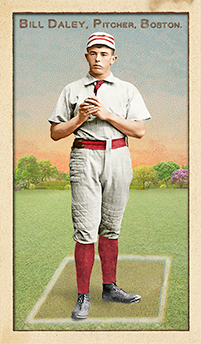
- Series: Beginnings: 1880's
- City: Boston
- Team: Beaneaters
- League: National League
William Daily (1868-1922) was a pitcher who had the rare opportunity of playing for two pennant winners, back-to-back, in two leagues. The only other team to do this was Brooklyn just prior to Daily’s Boston Reds/Beaneaters staging their coup in 1890/91. Daily had broken into pro-ball with the Jersey City Skeeters in 1887 as a 19-year-old. He came up with the NL’s second-place Beaneaters in 1889, getting into nine games and going 3-3. He stayed with most of his mates when they ventured into the Players’ League the following year and Ed excelled with an 18-7 record good for the league lead in winning percentage although Old Hoss Radbourn and Ad Gumbert won more for King Kelly’s Reds that championship season. Daily’s productivity dropped dramatically as the club joined the American Association in ’91, giving the young pitcher the chance to play in three leagues in consecutive seasons. After an 8-6 record, Bill returned to Buffalo/Albany through 1893.
- The Bridegrooms had performed their back-to-back feat in 1889-90 with the AA and the NL
- Series: Beginnings: 1880's
- City: Pittsburgh
- Team: Alleghenys
- League: National League
Abner Dalrymple (1857-1939) was one of the most prolific hitters of the fledgling NL. He was the leadoff batter for 8 straight years (with 5 pennants) for the Chicago White Stockings, contributing to a team home run record in 1884 that stood until eclipsed by the ’27 Bronx Bombers. He hit over .300 six times.
- Still shares a record for 4 doubles in 4 at-bats, July 3, 1883
- A.G. Spalding paid $2500 (!) to get Dalrymple from the Milwaukee Grays in 1878
- Dalrymple earned that confidence, winning the NL batting title in his rookie year
- In 1881 became first ever batter to be intentionally walked with bases loaded
- Dalrymple's uniform color in this card was changed from blue to red in August, 2017 to reflect recent reliable research conducted by Craig Brown and friends at Threads of Our Game. Two cards were previously released featuring a blue uniform

- Series: Beginnings: 1880's
- City: Chicago
- Team: White Stockings
- League: National League
Thomas Peter Daly (1866-1938) began his fine 16-year career as a catcher/second-baseman with the Chicago White Stockings in 1887 but was a mainstay with Brooklyn for 11 seasons, 1890-1901. Slightly-built and swift, “Tido” stole 385 bases, enabled by his .278 lifetime average that got him on base a lot for a catcher (he hit .294 in Brooklyn.) By the mid-nineties he had transitioned to the infield. Daly played for three pennant-winners in 1890, 1899 and 1900, all in Brooklyn. He is reported to have hit the first pinch-hit home-run in history on May 14, 1892 off John Clarkson. Tido was a “lifer” who stayed around the game in the minors as a player/manager and scout. He last played for the Johnstown Johnnies in 1907 and even managed for Toronto in 1932 at age 66.
- In 1891 Daly caught Tom Lovett’s no-hitter against the Giants
- Daly's uniform color in this card was changed from black to blue in March, 2017 to reflect recent reliable research conducted by Craig Brown and friends at Threads of Our Game. Four cards had been previously released featuring a black uniform.
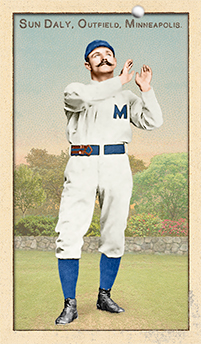
- Series: Beginnings: 1880's
- City: Minneapolis
- Team: Millers
- League: Western Association
James J. Daly (1865-1938) compiled a very short major league slash line. Sun made it to the big leagues with the Baltimore Orioles in 1892, joining one of the more ferocious teams of the era. He got into a mere 13 games and went 12-48 for a .250 average with seven RBI for the last-place team. With the likes of McGraw, Hanlon, Stovey and Wilbert Robinson - this was a down year for a team on the cusp of greatness. Already the squad was known for making its own rules and playing with a snarl. Thus, it was unlikely for a new kid to make the big club and Daly soon found himself back in the minors. He had begun playing ball in his hometown of Port Henry, NY and moved into the professional ranks with Portsmouth of the New England League in 1888. The next year he was out west with two Twin Cities clubs where he was photographed by the Old Judge crew. The Goodwin editors note that Daly was the poorest-fielding left fielder in the Western Association at that time. He returned east with Portland and Lebanon in '91 and began the '92 campaign with the Buffalo Bisons of the Eastern League. It is said that Daly acquired his nickname in the Buffalo outfield as he played the position while eschewing sun glasses. His distinctive moniker not enough to gain a toe-hold with the Orioles, Sun shuffled back to Buffalo for the '93-94 seasons. Daly then moved to Rochester for two years before wrapping it up in 1897 with stints for three Pennsylvania franchises: Reading, Scranton and Wilkes-Barre.
- Sun's best year at the plate was 1895 with Rochester where he hit .337 in 128 games, by far his most prolific season
- While his endurance at the pinnacle of his sport was short-lived, Daly set a much finer life-mark by living just long enough to celebrate fifty years of marriage to the mother of their four children

- Series: Beginnings: 1880's
- City: Chicago
- Team: White Stockings
- League: National League
Conrad Darling (1861-1904) was a modest-hitting journeyman catcher knocking around the hard-scrabble baseball towns of western Pennsylvania when The Sporting Life took note of his work following the 1886 season: “Darling was undoubtedly the most valuable man behind the bat in the International League.” Suddenly, Dell was in demand, spurning an offer from Jim Mutrie’s Giants and signing with Cap Anson’s Colts. He played well but sporadically until trying his fortune with Comiskey’s Chicago Pirates in the 1890 Players’ League. His career was in steep decline, likely due to the usual toll of catching in the big leagues. Dell played only part time for the Browns in ‘91 before hanging ‘em up. He did gain a short bit of notoriety by being implicated in a massive scheme to rob moving trains. He and other ballplayers were accused of pilfering baggage and tossing the spoils to confederates trackside. The publicity faded shortly with no indictment.
- The origin of Darling’s nickname is unknown but stayed with him through his obituary
- It was speculated that an old baseball injury contributed to Dell’s early demise
- Darling's uniform color in this card was changed from black to blue in March, 2017 to reflect recent reliable research conducted by Craig Brown and friends at Threads of Our Game. One card had been previously released featuring a black uniform.
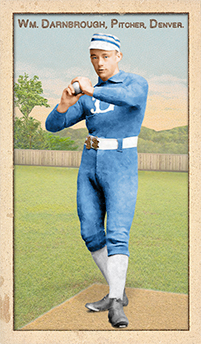
- Series: Beginnings: 1880's
- City: Denver
- Team: Grizzlies
- League: Western Association
William Darnbrough is another of the minor leaguers featured by Old Judge. They published 2 poses of this right-handed hurler in 1889 while he was with the Denver Grizzlies of the WA. Baseball-reference.com researchers have compiled a bare-bones profile of this player’s work for the Bloomington Reds of the Central Interstate League, Aurora of the Illinois-Iowa League, the Western League’s Kansas City Blues and Lincoln Rustlers and Darnbrough’s final assignment with the Rochester Flour Cities of the Eastern League. Most of the data is very sketchy, given the state of minor league ball in the 19th century. The year he met the Old Judge folks, Darnbrough had a busy year with a 12-14 record and a 4.37 ERA in 32 games. He got into 41 games as a batter with a .232 average. His play was more limited thereafter, but he closed his tenure in pro ball with a hefty .333 average for the Flour City lads (playing in only 6 games in their ’92 season).
- Darnbrough and his teammates were party to a blue law suit in Lancaster County, NE in 1891 – charged with unlawful play on Sunday, April 26 (before 3,000 similarly renegade fans)
- The case seems to have been brought to expose and overturn such prohibitions. The Nebraska Supreme Court eventually upheld the ban on Sunday play, a decision that would stand in the state until 1913
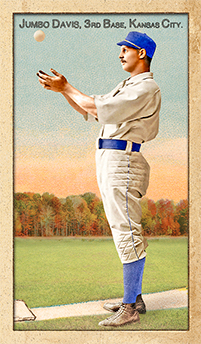
- Series: Beginnings: 1880's
- City: Kansas City
- Team: Cowboys
- League: American Association
James J. Davis (1861-1921) played 3rd base during 7 seasons for 6 major league teams (twice with Kansas City in different incarnations). He broke in with KC’s Cowboys of the Union Association in 1884 and later played for their American Association contingent in ’88-89. He also played for the Gladiators, Brooklyn’s Players’ League entry in 1890, finishing his time in the big leagues for the Washington Statesmen during their final year in the AA, 1891. “Jumbo” was a sturdy 5’11” and 195 lbs, hardly a giant but he must have impressed with his strength, leading the league in triples in ‘87 and generally hitting for a respectable average. His career BA was .272 with 468 hits in 453 games. The native New Yorker had begun minor league ball in 1883 with the Quincy, IL, Quincies in the Northwestern League (when Indiana, Illinois and Michigan were considered the “northwest”).
- In 1888, Davis saved a girl from drowning at the Coney Island shore while the Cowboys were on a road trip to NY
- Following his final game in D.C. “Big Jim” umpired some AA contests in 1891
- Also played for the Orioles and Browns, finding his post-retirement home in St. Louis
- Series: Beginnings: 1880's
- City: New York
- Team: Giants
- League: National League
Thomas H. Deasley (1857-1943) was a catcher for eight years for four ML clubs: the Boston Red Caps, St Louis Browns, NY Giants and Washington Statesmen from 1881 through ’88. This Irish immigrant compiled a .244 BA and did not hit a home run in the “Dead Ball” era.
- Pat’s best year was 1887 with the Giants, hitting .314 with a .367 OBP
- That NY team was noted for being nearly all Irish: Mike Dorgan, Pete Gillespie and Jim O’Rourke were the OF, while all but 2 innings in ’85 were pitched by Irishmen for example

- Series: Beginnings: 1880's
- City: Philadelphia
- Team: Quakers
- League: National League
Earle Harry Decker (1864-?) was a catcher for six teams over four seasons in the majors. He came into pro ball at an opportune time for a young man. 1884 saw the arrival of the short-lived Union Association whose entry into the “big leagues” allowed many minor league and marginal players a chance at the elite level, if only briefly. Harry was nothing if not opportunistic. He was clever enough to patent a thumbless catcher’s mitt (“The Decker Safety Catcher’s Mitt”) and cunning enough to pursue a criminal career that landed him in San Quentin prison under the name Earl Henry Davenport. Harry led a long life of crime, using multiple aliases, which has prevented baseball historians from tracking his life after baseball. He did show up in a team photo of the San Quentin squad and a reporter recalled him from his Keokuk days as a good defensive catcher. A versatile fielder, Decker played most positions but was a weak hitter, resulting in short stints in the majors followed by return to the minors (five teams in the US and Canada.)
- Harry’s most productive season was his last, with Pittsburgh, in 1890. He hit .274 in 92 games

















